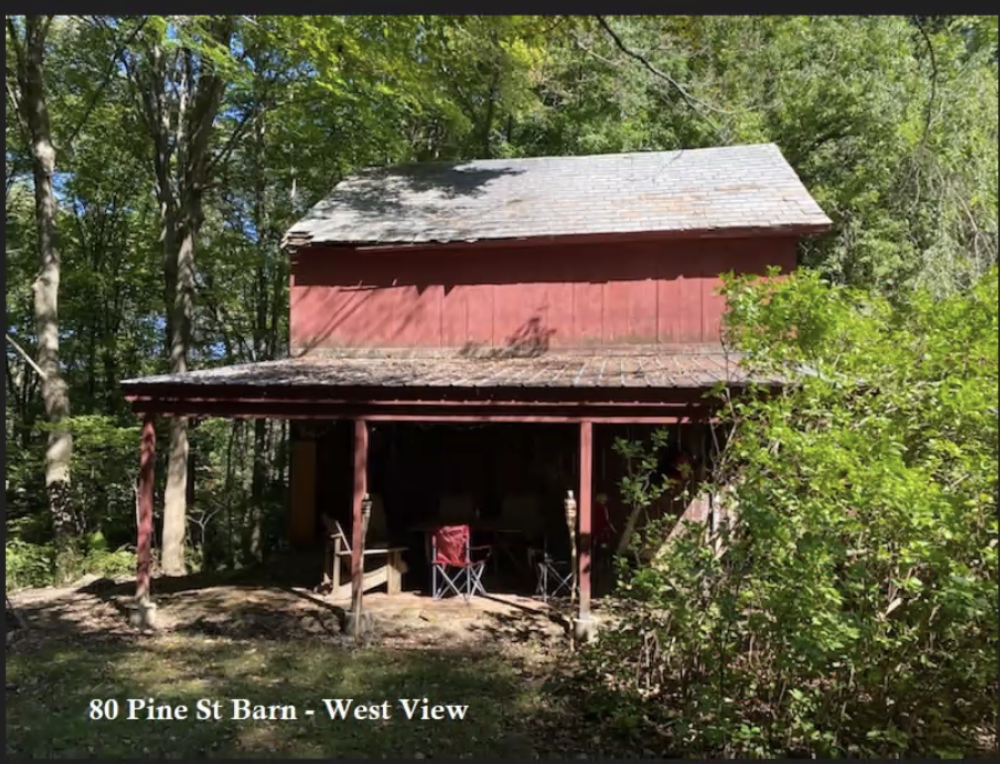Historic Commission Approves Two Projects. Continues To Discuss Modifications To Historic Preservation Bylaw

Barn slated to be demolished at 80 Pine Street. Photo: amherstma.gov
Report On The Meeting Of The Amherst Historical Commission, June 22, 2022
This meeting was held over Zoom and was recorded.
PresentCommissioners: Jane Wald (Chair), Jan Marquardt, Becky Lockwood, Pat Auth, Robin Fordham, and Hetty Startup
Staff: Ben Breger (Planning Staff liaison)
Demolition Of Farmhouse Approved For New Five College Credit Union
The Commission approved the demolition of a late 19th early 20th century farmhouse at 406 Northampton Road to make way for a new Five College Credit Union building approved by the Planning Board on June 1. Although the style of the farmhouse is typical of a rural farm homestead at the time it was built, the Commission felt that there are enough other extant examples in better condition to allow the Five College project to proceed. With no public comment, the Commission waived the demolition delay with the condition that the house be documented on the MACRIS system as a historical resource. The appellant agreed to comply.
No Recommendation Forwarded To The ZBA Regarding Pine Street Conversion
The Commission considered a recommendation to the Zoning Board of Appeals (ZBA) for its hearing June 23, 2022 for conversion of a Victorian home at 80 Pine Street into two non-owner-occupied four bedroom units. The Commission considered the proposed demolition of a c.1960 barn in poor condition. The Commission regulations require action on an application within 35 days but this application was filed the week before the May meeting which already had a full agenda of hearings. Because 42 days had passed, the Historical Commission could not issue a demolition delay, so the only recourse is to advise the ZBA about issuing a condition on the Special Permit. The discussion concerned the fact that the barn is not visible from the street and is a liability for the property owner due to its poor structural condition. Members felt the proposed two-story addition to the house is an improvement over the existing one-story ell to be replaced, but there seemed to be no consensus for a recommendation to ZBA.
Discussion Of Recently Passed Historic Preservation Bylaw Continues
On June 13, the town council voted to accept the proposed Historic Preservation Bylaw approved by the Community Resource Committee and the Planning Board. Several councilors expressed reservations about the new bylaw in that initial review was conducted by a single person. The council recommended that the Historical Commission set guidelines for evaluating whether a proposed demolition or alteration to a building over 75 years old needed to be reviewed at a public hearing or could proceed after the initial review.
Discussion of the goals for the on-going revision of the Preservation Plan continued. Jane Wald noted that the “Community Goals,” not the Commission’s goals, are part of the earlier 2005 document and the Master Plan also covers historic preservation. Hetty Startup noted that there has been lots of new construction in the last five years done with no understanding of preservation of the streetscape or value of the historic quality of the town [center] treasured by visitors and residents alike. Pat Auth noted that the historic houses on the west side of North Pleasant Street are in peril from continued development, and that the Commission’s goals should take an advocacy role in their preservation. She also felt that the goals should require that new development mirror the style of existing architecture although she noted that some members of the Local Historic District Commission which did not exist when the 2005 bylaw was passed had different ideas.
Wald lamented that Form-Based Zoning was defeated by Town Meeting but was reminded by a member of the public that the warrant article specifically concerned North Amherst whose residents deemed form-based zoning to be too urban for that National Historic District. Robin Fordham suggested an advocacy group outside the Commission, such as a “Friends of Preservation” since preserving neighborhood streetscapes would be work in addition to their official roles. Jan Marquardt felt that such a group could help stem “demolition by neglect” by educating the public where buildings are allowed to deteriorate until there is no choice but to tear them down. Her last word was that the Commission needs to emphasize its successes over the last fifteen years.
Vacancies Loom On Historic Commission
The Commission will have four positions to fill after June 30, including representatives to the Community Preservation Act Committee and the Design Review Board. With Wald’s term now ending on June 30, Marquardt and Fordham were voted Chair and Vice Chair, respectively to take effect immediately.
